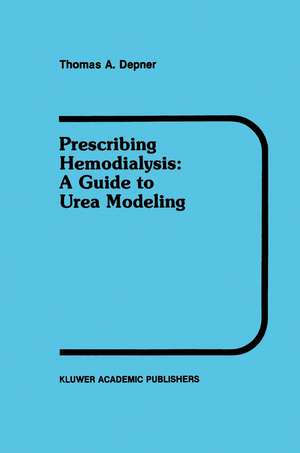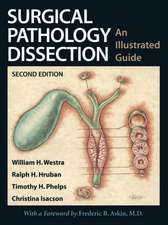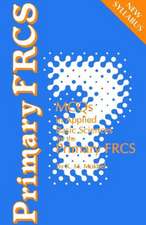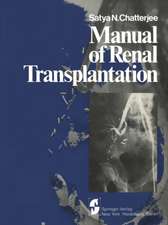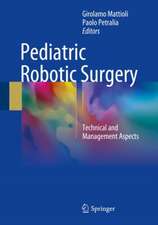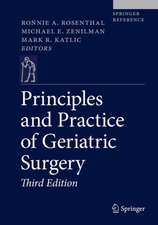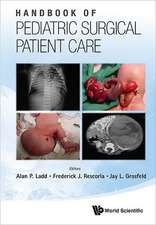Prescribing Hemodialysis: A Guide to Urea Modeling: Developments in Nephrology, cartea 29
Autor T.A. Depneren Limba Engleză Hardback – 30 noi 1990
| Toate formatele și edițiile | Preț | Express |
|---|---|---|
| Paperback (1) | 1410.97 lei 6-8 săpt. | |
| Springer Us – 26 sep 2011 | 1410.97 lei 6-8 săpt. | |
| Hardback (1) | 2358.20 lei 6-8 săpt. | |
| Springer Us – 30 noi 1990 | 2358.20 lei 6-8 săpt. |
Din seria Developments in Nephrology
- 5%
 Preț: 1611.20 lei
Preț: 1611.20 lei - 5%
 Preț: 1417.91 lei
Preț: 1417.91 lei - 5%
 Preț: 719.02 lei
Preț: 719.02 lei - 5%
 Preț: 1418.83 lei
Preț: 1418.83 lei - 5%
 Preț: 1418.48 lei
Preț: 1418.48 lei - 5%
 Preț: 1924.28 lei
Preț: 1924.28 lei - 5%
 Preț: 364.89 lei
Preț: 364.89 lei - 5%
 Preț: 369.84 lei
Preț: 369.84 lei - 5%
 Preț: 1098.48 lei
Preț: 1098.48 lei - 5%
 Preț: 1436.77 lei
Preț: 1436.77 lei - 5%
 Preț: 377.52 lei
Preț: 377.52 lei - 5%
 Preț: 722.12 lei
Preț: 722.12 lei - 5%
 Preț: 1419.20 lei
Preț: 1419.20 lei - 5%
 Preț: 370.01 lei
Preț: 370.01 lei - 5%
 Preț: 370.21 lei
Preț: 370.21 lei - 5%
 Preț: 385.57 lei
Preț: 385.57 lei - 5%
 Preț: 372.19 lei
Preț: 372.19 lei - 5%
 Preț: 1422.14 lei
Preț: 1422.14 lei - 5%
 Preț: 377.72 lei
Preț: 377.72 lei - 5%
 Preț: 713.18 lei
Preț: 713.18 lei - 5%
 Preț: 382.43 lei
Preț: 382.43 lei - 5%
 Preț: 2119.55 lei
Preț: 2119.55 lei - 5%
 Preț: 1103.75 lei
Preț: 1103.75 lei - 5%
 Preț: 1423.58 lei
Preț: 1423.58 lei - 5%
 Preț: 1415.54 lei
Preț: 1415.54 lei - 5%
 Preț: 388.12 lei
Preț: 388.12 lei - 5%
 Preț: 365.10 lei
Preț: 365.10 lei - 5%
 Preț: 362.72 lei
Preț: 362.72 lei - 5%
 Preț: 373.12 lei
Preț: 373.12 lei - 5%
 Preț: 1095.36 lei
Preț: 1095.36 lei - 5%
 Preț: 371.30 lei
Preț: 371.30 lei - 5%
 Preț: 1098.27 lei
Preț: 1098.27 lei
Preț: 2358.20 lei
Preț vechi: 2482.32 lei
-5% Nou
Puncte Express: 3537
Preț estimativ în valută:
451.38€ • 490.47$ • 379.41£
451.38€ • 490.47$ • 379.41£
Carte tipărită la comandă
Livrare economică 21 aprilie-05 mai
Preluare comenzi: 021 569.72.76
Specificații
ISBN-13: 9780792308331
ISBN-10: 0792308336
Pagini: 292
Ilustrații: XXIV, 292 p.
Dimensiuni: 155 x 235 x 19 mm
Greutate: 0.63 kg
Ediția:1991
Editura: Springer Us
Colecția Springer
Seria Developments in Nephrology
Locul publicării:New York, NY, United States
ISBN-10: 0792308336
Pagini: 292
Ilustrații: XXIV, 292 p.
Dimensiuni: 155 x 235 x 19 mm
Greutate: 0.63 kg
Ediția:1991
Editura: Springer Us
Colecția Springer
Seria Developments in Nephrology
Locul publicării:New York, NY, United States
Public țintă
ResearchCuprins
1. Uremic Toxins & Dialysis.- The uremic syndrome.- Role of protein nitrogen metabolism.- Clinical measurement of uremia.- Effect of dialysis on the uremic syndrome.- Proposed uremic toxins.- Alternatives to the single-toxin theory.- Protein and tissue binding of proposed uremic toxins.- Toxic contributions of dialysis itself.- Where urea fits into the toxin theories.- 2. Urea Metabolism: Clinical Chemistry of Urea.- Excretion of nitrogenous waste products: comparative physiology.- Biochemistry of urea.- Inborn errors of urea metabolism: urea cycle enzymopathies.- Urea transport.- Nitrogen recycling.- Methods of urea measurement.- The toxicity of urea.- 3. Urea Modeling: Introduction.- Definition of modeling.- Evolution of urea modeling.- Why urea instead of other solutes?.- Quantifying hemodialysis therapy.- Quality assurance programs and urea modeling.- Urea modeling development and techniques.- What is the purpose of urea modeling?.- Urea modeling for high-flux, short-duration dialysis.- What clinical data are provided by urea modeling?.- Significance of the urea distribution volume (V).- Significance of the urea nitrogen generation rate (G).- Components of the dialysis prescription.- Measures of prescription effectiveness.- 4. Single-Compartment Model.- Models for hemodialysis urea kinetics.- Overview of kinetic analysis.- Laws of diffusion.- First-order kinetics: clearance, rate constant, half-life, and exponential decline.- The single-compartment model.- Constant-volume model, three BUN measurements.- Evaluation of the constant-volume model.- Variable-volume model, three BUN measurements.- Source code for the variable-volume model, three BUN values.- Two-BUN method, variable volume.- Comparison of the two-BUN method with the three-BUN method.- Source code for thevariable-volume model, two BUN values.- 5. Multicompartment Models.- Urea compartments in normal humans.- Limitations of the single-compartment model.- Description of the two-compartment model.- Site of urea generation.- Postdialysis rebound in urea concentration.- Two-compartment modeling techniques.- Solutions to equations for the two-compartment model.- Graphic description of the two-compartment model.- High-flux dialysis and two compartments.- Solutes with low mass transfer coefficients.- Measuring the intercompartment mass transfer area coefficient.- A comparison of one-compartment with two-compartment models.- The direct quantification method.- Impact of pool number on calculated variables.- Determinants of postdialysis urea rebound.- Two-compartment model with variable ECF volume.- Two-compartment model with variable ECF and ICF volume.- The magnitude of intracellular swelling.- Additional compartments.- Recommendations regarding modeling with one versus two compartments.- Blood sampling techniques and precautions.- 6. A Practical Solution: Ureakin.- Value of the computer program.- Description of the program.- Theoretical basis for the program.- Conventions and assumptions.- Files and file extensions used by UREAKIN.- Options available from the main menu.- Refinements to UREAKIN.- 7. Refinements and Application of Urea Modeling.- Measuring blood urea concentrations.- Compensation for blood and plasma water content.- Dialyzer urea clearance.- Effect of fluid balance on kinetic measurements.- Recirculation of dialyzer venous blood.- Residual (native kidney) urea clearance: its significance.- Simplified methods for urea modeling.- 8. Measuring Dialysis: How Much is Enough?.- Historical methods.- Kt/V: A yardstick for dialysis therapy.- Measuring dialysis outcome.- The adequacy of dialysis.- Comparing dialysis outcome with the prescription.- 9. Examples of Urea Modeling.- Case 1: Expected results in an average adult patient.- Case 2: A case with no residual function and no weight gain between dialyses; the effect of changing Kd..- Case 3: The patient with significant residual renal function (Kr).- Case 4: Effects of habitually large weight gains between dialyses.- Case 5: The patient with high protein intake.- Case 6: The patient with low protein intake.- Case 7: The patient treated with high-flux dialysis.- Case 8: The patient whose dialyzer clearance (Kd) varies from the expected clearance.- Case 9: Small patients and the pediatric patient.- 10. The Future.- Dialysis versus other treatments for end-stage renal failure.- Outcome parameters for high-flux dialysis.- More complex models.- Modeling other solutes.- Better markers for uremia.- Improved blood flow monitoring.- Dialysate modeling.- Real-time monitoring of urea kinetics.- Urea modeling from the total-care perspective.- Appendicies.- Appendix A. Source code for a single-compartment, variable-volume model: three-BUN method.- Appendix B. Source code for a single-compartment, variable-volume model: two-BUN method.- Appendix C. Source code for a two-compartment, fixed-volume model.- Appendix D. Numerical solution for a two-compartment, variable-ECV model.- Appendix E. Description of a two-compartment, osmotic model with variable ECV and ICV.- Appendix F. Interpreting the results of urea modeling.- Appendix G. Useful equations.- Appendix H. Examples of data collection forms.- Appendix I. Examples of modeling reports.
